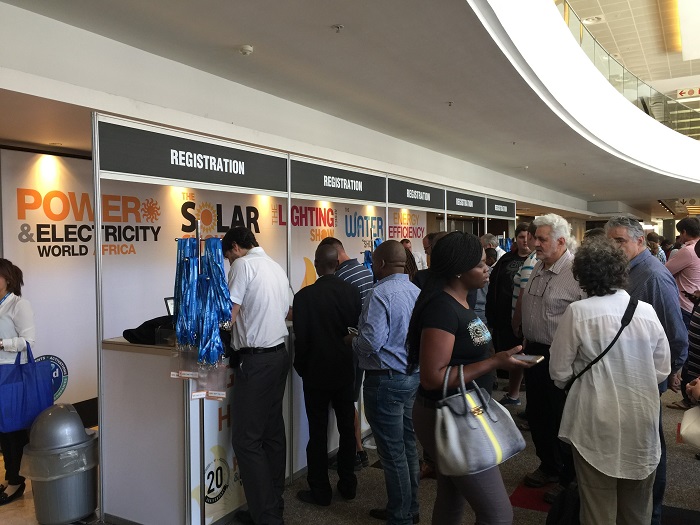pv magazine met with South Africa’s leading PV distributor Rubicon on the final day of the two-day exhibition and conference. Rubicon’s Technical Director Nick Roche pointed to the company’s success in the commercial and industrial (C&I) market, which he forecasts to grow to 250 MW this year, which would be more than double the annual figure for 2015.
Off-grid systems also show strong growth, and in some cases there is an overlap with C&I installations. Luxury safari lodges, for example, are often in remote locations and are therefore a combination of C&I and off-grid. Rubicon was the first distributor to partner with Tesla to bring Tesla’s Powerwall to the local market. While the battery and electric car manufacturer’s initial Powerwall 1 did not feature the capabilities required for off-grid applications, Tesla’s Powerwall 2 is a perfect fit for projects like off-grid safari lodges.
On the residential side, the country’s national utility Eskom has not taken the leadership role it has shown on the REIPPP (Renewable Energy Independent Power Producer Procurement) front. With 4 GW awarded to date and an overall investment of $14 billion, the REIPPP program stands out as Africa’s leading solar PV program. And at The Solar Show Africa conference this week, Mr. Chidi Izuwah, Executive Director, Support Services Department of Nigeria’s Infrastructure Concession Regulatory Commission, called on governments in other African countries to make REIPPP a model other parts of Africa should follow.
On the other hand, Eskom has been slow to move on the residential front. Only a handful of South Africa’s +400 municipalities allow net metering in some shape or form. Eskom has been resisting more widespread PV feed-in and at The Solar Show Africa exhibition various vendors like Austrian inverter manufacturer Fronius showcased equipment enabled to prevent PV power from getting to the distribution grid.
With load shedding no longer a key driver as in previous years, and residential electricity rates in the range of only 11-12 US$-cents per kilowatt-hour, there is little driving residential PV adoption.
The business case
As Nick Roche of Rubicon points out, C&I projects benefit from a very lucrative one-year tax write-off if the installation is under 1 MW. He points to a payback period of just 3.5 years for a recent 700 KW C&I project in Johannesburg and, not surprisingly given these attractive payback times, significant interest among the country’s professional investors for this asset class. Typically, a fund will take ownership of the C&I PV system and gain its return via a long-term power purchase agreement (PPA) with the commercial or industrial off-taker.
Popular content
Investors like these South African funds demand long-term performance with minimal risks, and Rubicon’s emphasis on quality components makes them the ideal partner for such investors. Rubicon only works with best-of-breed manufacturers like Tesla, Stäubli-MultiContact and SolarEdge.
Another cooperation promoting quality and reliability was on display at the booth of SoloPower Systems. The U.S. manufacturer of flexible thin-film PV has teamed up with German chemicals giant BASF to supply a lightweight and weatherproof roofing component outfitted with SoloPower’s thin-film sheet as its top layer. Thin-film has significant advantages when it comes to shading and performs better than mono- and polycrystalline modules in high temperature environments. Next to its energy-producing properties, the BASF-SoloPower roofing sandwich provides state-of-the-art insulation, so significant energy savings as well. As Angus Peruzzo, Managing Director of BASF Construction Chemicals South Africa (Pty) Ltd, pointed out to pv magazine, target markets in South Africa include township communities, as well as new warehouses and other C&I structures.
Thin-film’s capabilities were also on display at the Barloworld Power-Caterpillar booth, which showcased Caterpillar’s cooperation with thin-film leader First Solar to address large-scale C & I and off-grid opportunities in Africa and other markets around the world. Working together with its African partner Barloworld Power, these opportunities in Africa include the mining sector, where Caterpillar and Barloworld are already established suppliers, be it on the conventional energy side or the supply of heavy duty construction equipment.
For those visitors of The Solar Show Africa who needed a hands-on demonstration of thin-film’s advantages, South African PV distributor Sintech Advanced Power Products (Pty) Ltd. offered the perfect display: two small modules, one thin-film (from Solar Frontier) and the other multicrystalline, were placed side-by-side under two lamps, each one powering a small fan when the lights were turned on. By passing a hand under the lamps, the resulting shading stopped the fan powered by the crystalline panel, while the thin-film fan kept on humming.
As Sintech’s CTO Chris Sachse revealed to pv magazine at their booth, the company has put together an extensive outdoor test system to evaluate various module technologies and how they perform in the hot African environment. Such initiatives will also contribute to improving the quality and reliability of African PV installations going forward.
This content is protected by copyright and may not be reused. If you want to cooperate with us and would like to reuse some of our content, please contact: editors@pv-magazine.com.


By submitting this form you agree to pv magazine using your data for the purposes of publishing your comment.
Your personal data will only be disclosed or otherwise transmitted to third parties for the purposes of spam filtering or if this is necessary for technical maintenance of the website. Any other transfer to third parties will not take place unless this is justified on the basis of applicable data protection regulations or if pv magazine is legally obliged to do so.
You may revoke this consent at any time with effect for the future, in which case your personal data will be deleted immediately. Otherwise, your data will be deleted if pv magazine has processed your request or the purpose of data storage is fulfilled.
Further information on data privacy can be found in our Data Protection Policy.